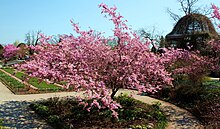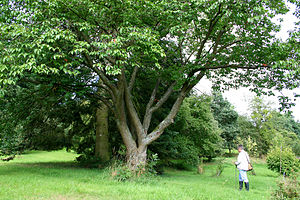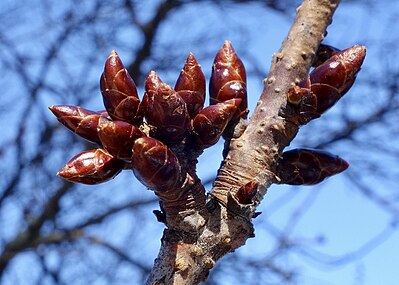| Prunus sargentii | |
|---|---|

| |
| Conservation status | |
 Least Concern (IUCN 3.1) | |
| Scientific classification | |
| Kingdom: | Plantae |
| Clade: | Tracheophytes |
| Clade: | Angiosperms |
| Clade: | Eudicots |
| Clade: | Rosids |
| Order: | Rosales |
| Family: | Rosaceae |
| Genus: | Prunus |
| Subgenus: | Prunus subg. Cerasus |
| Species: | P. sargentii |
| Binomial name | |
| Prunus sargentii Rehder | |
| Synonyms | |
| |
Prunus sargentii, commonly known as Sargent's cherry or North Japanese hill cherry, is a species of cherry native to Japan, Korea, and Sakhalin (Russia).
The tree was named for Charles Sprague Sargent.
Description

Prunus sargentii is a deciduous tree that grows 20–40 ft (6.1–12.2 m) tall and broad. New growth is a reddish or bronze color, changing to shiny dark green. The obovate leaves with serrated margins are 3–5 inches (7.6–12.7 cm) in length and are arranged alternately. In fall, the leaves turn red, orange, or yellow. It grows single pink flowers on 1-in pedicels, which result in purple-black fruit in summer. The fruits are a favorite of birds, but because of their size (small, pea sized) and color, are considered inconspicuous to humans.
Cultivation
P. sargentii is a fast-growing ornamental tree requiring sun and well-drained soil. The tree can tolerate wind, but not air pollution; it is one of the hardiest cherries, and can be easily transplanted. This makes it suitable for use as a street tree. The tree is moderately drought-tolerant.
History
Native to Korea and Japan, the tree was introduced to America and then the United Kingdom in 1908.
Gallery
-
 Buds
Buds
-
 Flowers
Flowers
-
 Flower detail
Flower detail
-
 Prunus sargentii, 1928 accession (#794-28*B) Arnold Arboretum of Harvard University
Prunus sargentii, 1928 accession (#794-28*B) Arnold Arboretum of Harvard University
-
 Flowers
Flowers
See also
- For cherry blossoms and their cultural significance to the Japanese, see sakura.
References
- Rivers, M.C. (2021). "Prunus sargentii". IUCN Red List of Threatened Species. 2021: e.T64127603A64127606. Retrieved 12 September 2022.
- Bailey, L.H.; Bailey, E.Z.; the staff of the Liberty Hyde Bailey Hortorium. 1976. Hortus third: A concise dictionary of plants cultivated in the United States and Canada. Macmillan, New York.
- Common Trees of Hokkaido, pg 104
- Royal Horticultural Society Archived 2007-10-22 at the Wayback Machine, What's On, Harlow Carr, October 2007, last access 31 May 2008.
- ^ Evans, Erv (2000–2003). "Prunus sargentii". Plant Fact Sheets. North Carolina State University. Archived from the original on 2008-05-15. Retrieved 2008-07-04.
- ^ Brand, Mark (1997–2001). "Prunus sargentii". UConn Plant Database of Trees, Shrubs, and Vines. University of Connecticut. Archived from the original on 2008-05-12. Retrieved 2008-07-04.
- Gilman, Edward F.; Dennis G. Watson (n.d.). "Prunus sargentii: Sargent Cherry" (PDF). Environmental Horticulture Department, Florida Cooperative Extension Service, Institute of Food and Agricultural Sciences, University of Florida. Retrieved 2010-10-11.
- "Prunus sargentii". Germplasm Resources Information Network. Agricultural Research Service, United States Department of Agriculture. Retrieved 2008-07-07.
- "Prunus sargentii (Sargent's Cherry)".
- Common Trees of Hokkaido, Hokkaido University Press, Sapporo, 1992, ISBN 4-8329-1032-9 C0045 P2472E
External links
- "Prunus sargentii". Plants for a Future.
- Prunus sargentii images at the Arnold Arboretum of Harvard University Plant Image Database
- "Cherry: Prunus ssp. - April Tree of the Month." Arnold Arboretum of Harvard University website, 2015. Accessed 1 May 2020.
| Taxon identifiers | |
|---|---|
| Prunus sargentii |
|
| Prunus sachalinensis | |
| Prunus serrulata var. sachalinensis | |